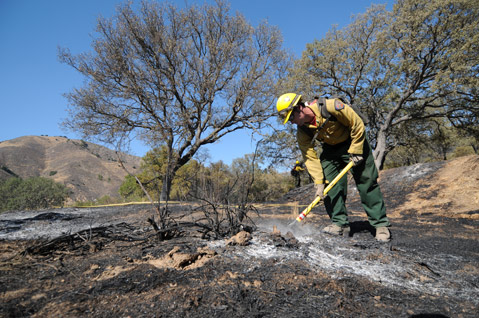
With the smoke just settling from the White Fire, Santa Barbara’s first serious backcountry inferno this year, word leaked out that 20 of the 27 Hot Shots stationed at Vandenberg Air Force Base — highly trained, elite firefighters — have been laid off and 57 of the civilian firefighters on the base have been placed on furlough. Translated, that means those 57 firefighters will be forced to take one day off a week, without pay, for the next 11 weeks.
Congressmember Lois Capps sounded the alarm with a blistering press release on Thursday. Immediately triggering the force reduction is what’s known as “sequestration” — the mandatory widespread federal budget cuts forced by the inability of Republicans and Democrats to come to terms regarding the nation’s deficit. But Capps’s press spokesperson Ashley Schapitl noted that even before sequestration, firefighting agencies defending the Los Padres National Forest had been struggling to make do with less.
“It’s one less crew available for the initial attack,” said Carrie Landon, the new fire chief of the Los Padres National Forest, of the loss of Hot Shots. For Landon, just four weeks on the job, this week’s White Fire — which chewed up nearly 2,000 acres by Paradise Road — was truly a baptism by fire. Landon described the Hot Shots as “a very elite hand crew, the most experienced in the nation.” She said the Forest Service has two Hot Shot crews of its own assigned to the Los Padres National Forest, adding that reinforcements are possible upon demand. But Landon’s public information officer Andrew Madsen noted that the Vandenberg Hot Shots have played a significant role in fighting every major backcountry blaze he can remember and were always represented on the incident command teams.
This loss compounds the decision by the Santa Barbara County Fire Department to discontinue its own hand crew of 25 seasonal firefighters last year because of budget pressures. “You feel the loss,” said County Fire Chief Mike Dyer. “You feel like you’re going to a knife fight armed with a butter knife. You can still do it, but it will take you a little longer.” By that Dyer meant the resources would ultimately be made available, just not as swiftly as if they were already there. “It weakens your ability to control and suppress the initial outbreak.”
Ground crews are one of many “tools” dispatched to fight forest fires, along with helicopters, air tankers, bulldozers, and fire engines. Ground crews get as close and personal with the flames as deemed safe given prevailing wind patterns, cutting lines and fire breaks necessary for containment. Some ground crews establish what are known as “spike camps” near the fire and remain embedded there for as long as a week. They are especially crucial in tough terrain not accessible by truck.
Nationally, the Forest Service took a $50 million hit in its firefighting funding because of sequestration, meaning 500 fewer temporary firefighters and 50 fewer engines. But Chief Landon of the Forest Service said those cuts have not affected the Los Padres National Forest. She said 300 firefighters — both permanent and temporary — have been assigned to the Los Padres National Forest for the fire season. Of those, she said, 115 are temporary. There was a slight glitch initially, she said, in ordering the full retinue of temporary firefighters, but that was solved by requisitioning them through “emergency” hires.
Chief Dyer gave the Forest Service high marks for its assertive reaction to the White Fire, saying he’s seen a significant increase in how aggressively the agency has responded to forest fires in the four years he’s been on the job. “I saw a robust response,” he said. In other parts of the country, forest officials are inclined to simply let some fires go. But given the high value — and proximity — of Santa Barbara’s real estate, that’s not an option. “This isn’t Montana,” Dyer said. “You can’t just let it burn out there. If you do, it will become a problem.”



